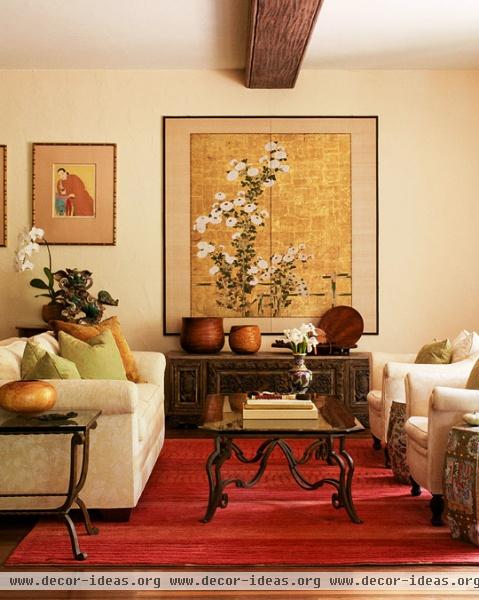East Meets West: Hawaiian Home

East Meets West: Hawaiian Home
Design:
Interior design: Mary Philpotts McGrath, Philpotts & Assoc. Inc., 40 S. School St., Suite 200, Honolulu, HI 96813; 808/523-6771, philpotts.net.
Photographs by Joe Schmelzer
Text by Candace Ord Manroe
Produced by Krissa Rossbund
Just because someone lives on an acre of rain forest cut by a cold mountain stream in a historic Hawaiian home filled with exotic treasures three minutes from downtown Honolulu, that doesn't mean she's in paradise, does it? Mary Philpotts McGrath, lucky girl, must admit that it does.
Born and raised on Oahu with Hawaiian lineage through her mother, Mary is among Hawaii's best-known interior designers and exponents of its East-meets-West style. (Her daughter, Marion, who lives next door, is also a designer at Philpotts & Associates.) From architecture to orchids, Mary embraces all things Hawaiian.
"Our home is signed by Hart Wood," she proudly reports of the 90-year-old house she shares with her husband, John Williams McGrath. To those with a knowledge of Hawaiian architecture, that's a bit like citing Moses as the provenance of certain stone tablets in one's personal possession; Wood is the source of the style. After moving to Honolulu in 1919, he consciously crafted a distinctive Hawaiian architecture using indigenous materials, forms that functioned optimally with the weather, and an amalgam of Eastern and Western design elements that made sense for the Pacific Rim.
"What this house [and Hawaiian] style is, essentially, is eclectic," says Mary. "Some features--like the roofline [steep, double-pitched]--are uniquely Hawaiian, and other elements are Chinese. Because Wood was a classically trained architect, you also see a strong European influence in his proportions."
Those proportions are what first drew her to the house. "The width, length, and height of every room are all pleasing. I also was attracted to Wood's attention to detail. From the entry to the living room, the dining room, and the family room, the house has no interior doors, just framed portals. The entire first floor is all opened up through these wide apertures. Wood articulates the detailing of each space beautifully while still using a common vocabulary," explains Mary.
Ahead of its time for mainstream architecture, the open concept was less an aesthetic objective than a functional one. "With the windows and exterior doors open, the trade winds are free to move and cool the house," explains Mary.
When the McGraths bought it 20 years ago, the house was in superb condition. Aside from lightening the family room's paneling back to its original pickled finish, they've had to do little to improve it. Mary credits Wood's choice of materials. From the ground up, he built the entire first floor with stone. "It was the basalt stone laborers would chip out of the fields when they were not working the pineapple and sugar cane plantations," Mary explains. "It was used in rectangular blocks and covered with a plaster mortar. It remains the same temperature all year long. I believe it's what has given this house longevity."
Other materials that merit credit include termite-impervious ohia, an indigenous and increasingly rare wood that grows near volcanoes and covers most of the rooms' floors. The original flooring in the family room--as ahead of its time as the open floor plan--is black-stained concrete.
Along with scoring an important piece of Hawaii's architectural heritage, Mary considers herself nearly as fortunate to have purchased many of the home's original furnishings. Artworks like the living room's large framed Japanese screen are ideally suited to the scale of the house. "It was a matter of rearranging and moving things. I don't think I left a single piece in its original place," she says.
Furnishings original to the house, such as the massive antique Venetian gilded mirror that stretches almost to the ceiling, fascinate Mary. "The original owners were German, and like most immigrants to Hawaii, their furnishings came from all over the world. I just can't imagine how they shipped them here."
Each piece tells the home's history, and Mary happily enriches the story with some offerings of her own. The couple's collection of new to 200-year-old bowls crafted from native Hawaiian woods is displayed throughout the home. "Collecting is a by-product of my profession," Mary jokes. "Many of these bowls and vessels were revered items presented to commemorate an occasion or used in food ceremonies. They're a part of our cultural history." Neatly pulling them together with the European antiques and Japanese art are some practical Hawaiian decorating approaches. "Bare feet, bare floor," laughs Mary. "We prefer to leave our windows bare and our floors minimally covered. We prefer to look outside--to live in our gardens."












